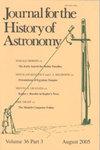弥合考古学和古天文学之间的差距
IF 0.3
3区 哲学
Q3 HISTORY & PHILOSOPHY OF SCIENCE
引用次数: 0
摘要
椅子。真的很舒服吗?主席对“用户的社会和认识权威”的所谓意义与19世纪天文台实施的严格等级制度有何关系?正如纳西姆在第一章中所描述的那样,像乔治·艾利这样的天文学家几乎从不坐在观测椅上。他们也没有把这位辛勤工作的观察者描绘成一位精力充沛的科学家。那么,这些相互竞争的图像是如何结合在一起的,又如何确保公众选择了想要的图像呢?因此,尽管与椅子的相对图像形成了鲜明对比,但19世纪天文学图像的轮廓仍然开始模糊。或者有人想知道当女性坐在观察椅上时发生了什么。他们是否感受到了“男子汉气概”的流动?这本书中很少有女性坐在天文台椅子上的插图,也许也不多。不过,很有意思的是,他们是否曾被展示过斜倚,是否曾在科学行动中被展示过。这会改变女性在(科学)社会中的地位吗?它会改变天文学家椅子的代表性区域吗?尽管存在这些问题,《天文学家的椅子》是一部鼓舞人心的研究,事实上,它也是一部文化史,它将人们的注意力引向了即使是最平凡的科学对象周围也存在着影响深远的相互依存和关系的密密网。本文章由计算机程序翻译,如有差异,请以英文原文为准。
Bridging the gap between archaeology and archaeoastronomy
the chair. Was it indeed comfortable? And how does the alleged significance of the chair for the ‘users’ social and epistemic authority’ relate to the strict hierarchies enforced in 19th-century observatories? As Nasim thematises in Chapter 1, astronomers like George Airy hardly ever sat on the observation chair. Nor did they spread an image of the labouring observer as an energetic scientist. So how do these competing images come together, and how could one be sure that the public chose the one intended? Thus, despite the sharp contrast to the opposed image of a chair-less other, the contours of the image of 19th-century astronomy still begin to blur. Or one wonders what happened when women sat in the observation chair. Did they feel the flow of ‘manly energies’? The book presents few illustrations of women in observatory chairs – and maybe there aren’t many. It would be interesting to know, though, whether they were ever shown reclining, ever shown in scientific action. Would that have altered women’s standing in (scientific) society? Would it have transformed the representational field of the astronomer’s chair? Notwithstanding these questions, The Astronomer’s Chair is an inspiring study, and, indeed, a cultural history, which directs attention to the dense net of far-reaching interdependences and relations that surrounds even the most mundane objects of science.
求助全文
通过发布文献求助,成功后即可免费获取论文全文。
去求助
来源期刊

Journal for the History of Astronomy
地学天文-科学史与科学哲学
CiteScore
0.50
自引率
25.00%
发文量
44
审稿时长
>12 weeks
期刊介绍:
Science History Publications Ltd is an academic publishing company established in 1971 and based in Cambridge, England. We specialize in journals in history of science and in particular history of astronomy.
 求助内容:
求助内容: 应助结果提醒方式:
应助结果提醒方式:


